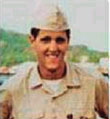Editorial Comment
A legend passes on. It would be unlikely for you not to have heard of the recent death of legendary oil well blowout specialist Paul N. “Red” Adair. But I know from traveling that what is widely reported in Houston may not be in the rest of the world. I met the man briefly in the early 1980s on an offshore job, where the wellhead had come out of the ground about six feet and rotated 90°. A quick-thinking driller saved the day by managing to get a chain on it while all hands scattered. I was a well-logger at the time. As it turned out, we never needed Red's services: the blowout stayed well into the subsurface at the parted casing. (But I did get a handful of his company stickers, which were better than money when needing help on a drill floor.) He seemed like a fine fellow. Red Adair died of natural causes at the age of 89. His 50-year career in controlling blowouts began at a time when the technology was not very far advanced. He turned doubters into converts with each new invention and technique, squelching more than 2,000 blowouts. Some of the most noteworthy included killing the Bravo offshore blowout in 1977 and the Piper Alpha disaster in 1988, both in the North Sea, the latter of which killed 167 men, and the long-lived Ixtoc-1 blowout in the Gulf of Mexico in 1979. He is especially remembered for putting out 119 of the 700 fires in Kuwaiti oil fields after the first Gulf War. Although he developed many new techniques, he is not the “father” of oil well blowout control. That title, if there is one to be bestowed, belongs to Myron Kinley, who trained Adair, “Boots” Hansen, and “Coots” Matthews. In 1959, Adair bought Kinley's equipment for $125 and started the Red Adair Co. Red's legacy got me thinking about blowouts... Banning the blowout? I've had conversations with environmentalists along the following lines, and it happened again recently with an oilfield friend. We were talking about Red and wondering how blowout science had progressed over the years, and whether there were any statistical trends that were known. When talking to a staunch environmentalist, my usual approach for the “access” argument is to point out how good our industry has become over the decades: the effect of multilaterals and large-ID tubing, resulting in small footprints and rapid depletion; extended reach; and zero discharge. My opposer's predictable retorts are: “Remember Lake Maracaibo and Ixtoc-1?” and, “Have you banned blowouts?” My usual responses are: “I can't help what Venezuela does;” “The 4 million barrels spilled from Mexico's Ixtoc-1 blowout was a rare, historical event that might never be repeated;” and, “I have no idea how blowouts are trending.” I know of no worldwide statistical sources on blowout trends. These are usually kept by government agencies, whether, and as, they see fit. World Oil published research by Pal Skalle and Anthony Podio in our June 1998 issue. The conclusion was that, over the period studied (1960 – 1996) covering the US Gulf Coast, “The data shows that blowouts continue to occur at about a constant rate.” Still, the real question we need answered is: How are oil spills faring as a result of blowouts over time? I'll bet they're decreasing, but can't prove it. I found a 1999 reference from a Georges Bank report that stated, “For exploration wells, US blowout frequency has been one for every 180 wells drilled. Within the GOM, 21% were controlled within one hour, 84% within one week, and 95% within one month.” The report further states that there are inherent advantages to pre- and post-planning to control pollution from a well blowout compared to other, much larger pollution sources, such as tankers. I firmly believe that sometimes, it's just an unfortunate choice of a name or designation that puts certain areas of the world off limits. If many decades ago an area was named, “Sacred Burial Place of the Beautiful Gaeliaia,” and is subsequently designated a wildlife, natural area or similar, the chance that it will ever get drilled drops to near zero. Often, there's just as much beauty, wildlife or whatever next door, but that area gets explored and drilled routinely and safely, because it lacks the designation. Have we banned the blowout? Of course not. But are we even making progress, oil-spill wise? I have no idea. Maybe somebody reading this does. A good soul and a great nut. The Internet is good for a lot of things, but sometimes, the vile element dominates, and that seems to be what has happened to Jim Nabors. You may recall that he brilliantly portrayed the character Gomer Pyle, an innocent country hick, on The Andy Griffith Show and Gomer Pyle, USMC. His toothy “gawleee” and bug-eyed “shazzaym” expressions became part of the American vernacular – indeed, perhaps the world's, as I've seen reruns in many countries. Rarely has a performer had a number-one rated comedy, a top ten variety show, a talk show and several television specials, plus performances in stage productions and innumerable concerts. Add to that a singing career – he has recorded 28 albums and has earned five gold and one platinum record – and roles in numerous movies, and you'll see that he is truly a remarkable entertainer. Thus, I was saddened to see his picture on the Internet lately, with the caption, “Pick the Gomer.” It seems a shame to sully the reputation of such a good actor and singer by sandwiching him between two politicians.
Jim spends much of his time in Maui, Hawaii, on his macadamia nut farm, where he also grows tropical flowers. We wish him well.
|
||||||||||||||||||
- Prices and governmental policies combine to stymie Canadian upstream growth (February 2024)
- U.S. producing gas wells increase despite low prices (February 2024)
- U.S. drilling: More of the same expected (February 2024)
- U.S. oil and natural gas production hits record highs (February 2024)
- U.S. upstream muddles along, with an eye toward 2024 (September 2023)
- Canada's upstream soldiers on despite governmental interference (September 2023)
- Applying ultra-deep LWD resistivity technology successfully in a SAGD operation (May 2019)
- Adoption of wireless intelligent completions advances (May 2019)
- Majors double down as takeaway crunch eases (April 2019)
- What’s new in well logging and formation evaluation (April 2019)
- Qualification of a 20,000-psi subsea BOP: A collaborative approach (February 2019)
- ConocoPhillips’ Greg Leveille sees rapid trajectory of technical advancement continuing (February 2019)







